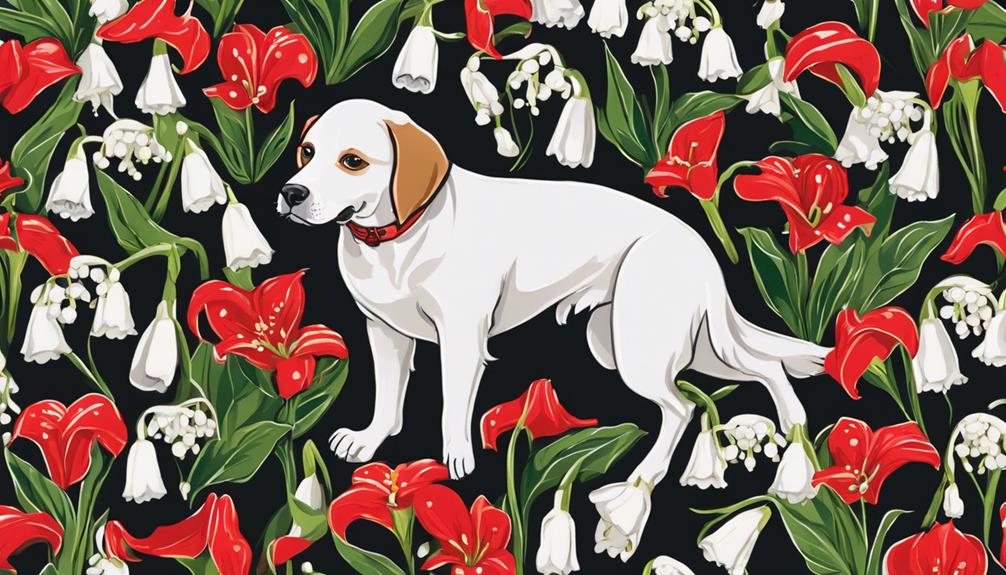Yes, dogs miss their owners. When separated, they may exhibit behaviors such as whining, pacing, and seeking the owner’s scent. These actions demonstrate their emotional connection and desire for comfort. Recognizing these signs is crucial. You can offer soothing items and maintain routines. Nurture your bond with your dog to alleviate their distress. By acknowledging and attending to their behaviors, you can provide better support. This is just the starting point; there is so much more to discover about how to comprehend and assist your furry friend in dealing with missing you.
Key Takeaways
- Dogs display signs of missing owners through behaviors like whining and seeking out scents.
- Recognizing and addressing separation anxiety is crucial for understanding dogs' emotions.
- Providing comfort items, routines, and bonding activities helps alleviate dogs' distress.
- Dogs cope with longing by engaging in activities, seeking familiar scents, and waiting by doors.
- Strengthening bonds with play, routines, and positive interactions enhances the relationship.
Signs of Separation Anxiety in Dogs
When we observe our dogs exhibiting destructive behaviors like chewing furniture or shoes, it may indicate signs of separation anxiety. Dogs experiencing separation anxiety may resort to such destructive actions as a way to cope with the stress of being apart from their owners.
Along with destructive behaviors, other signs of separation anxiety in dogs include urinating or defecating inside the house when left alone. This behavior is their way of expressing distress and anxiety over being separated from their beloved humans.
Additionally, dogs with separation anxiety may excessively bark, howl, or whine when their owners aren't present. These vocalizations are a clear indicator of their discomfort and longing for their owners' presence.
Physical symptoms such as excessive drooling or panting can also manifest in dogs with separation anxiety. These signs collectively point towards the emotional distress our furry companions endure when faced with separation from their owners.
Behavioral Indicators of Missing Owners

Exhibiting behaviors like whining, pacing, and seeking out their owner's scent, dogs unmistakably show signs of missing their beloved humans. These signs of missing owners are important to recognize as they help us understand what our furry companions are feeling.
When our dogs display these behaviors, it's important to acknowledge their emotions and take steps to help them feel more secure. Providing comfort items like a favorite toy or blanket that smells like their owner can offer reassurance. Additionally, maintaining a consistent routine and spending quality time with our dogs can help alleviate their feelings of loneliness.
Observing and responding to these signs of missing can strengthen the bond between us and our dogs, creating a sense of trust and security. By recognizing and addressing these behaviors, we can guarantee that our dogs feel loved and connected even when we're apart.
Emotional Display of Dogs Missing Owners
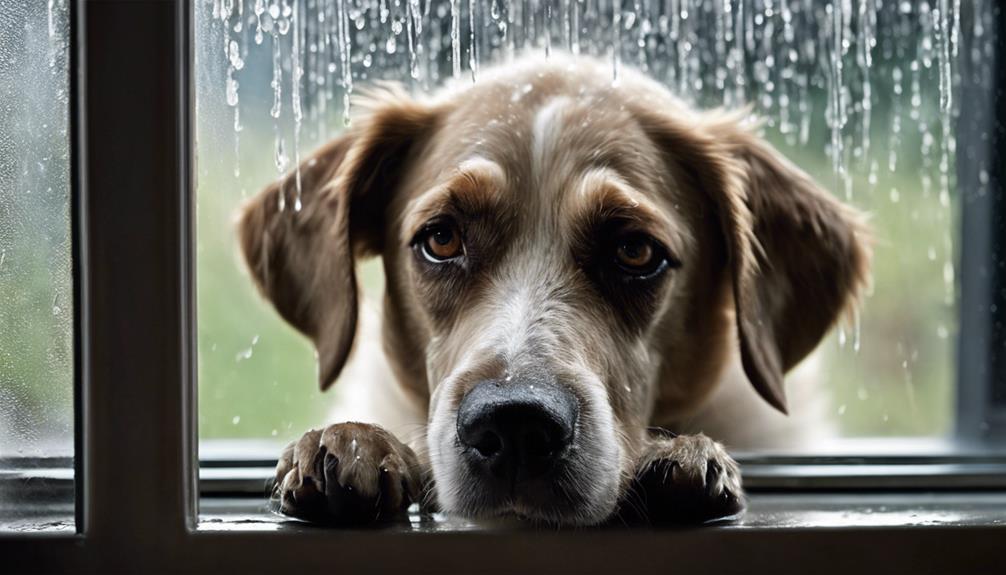
Upon their owner's absence, dogs often display a range of emotional behaviors that unmistakably convey their longing for their beloved humans. When a dog misses us, they may exhibit various signs of separation anxiety, indicating their emotional distress at being apart.
Here are some common signs your dog misses you:
- Pacing and restlessness: Dogs may walk back and forth anxiously, unable to settle down in your absence.
- Whining or howling: Vocalizations like whining or howling can be your dog's way of expressing their sadness and desire for your return.
- Seeking comfort: Dogs may seek out items that carry your scent, like clothing or blankets, to find solace and feel closer to you.
It is essential to recognize these signs of separation anxiety in our furry friends, as understanding their emotions can help us support them better during times of absence. Being aware of these behaviors allows us to provide comfort and reassurance to our dogs, strengthening the bond we share with them.
Understanding Canine Longing
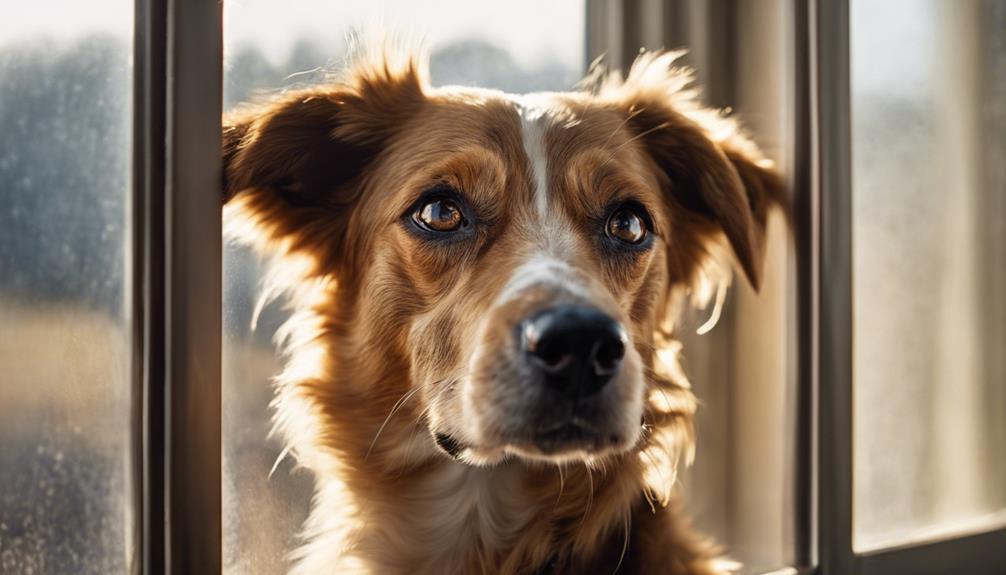
Dogs unmistakably convey their longing for their owners through a range of emotional behaviors. Our furry friends may exhibit signs of stress like whining, pacing, or even becoming overly excited upon their owner's return. Some dogs seek out their owner's scent, engage in destructive behavior, or wait by the door, all clear indicators that they're missing their beloved humans.
It's not uncommon for dogs to show their sadness by being mopey, sleeping on their owner's belongings, or attempting to escape to find them. Understanding these signs is vital in helping our canine companions cope with their longing. Providing ample exercise, leaving familiar scents behind, using calming music, and ensuring they're occupied can all aid in easing their distress.
Coping Mechanisms for Dogs
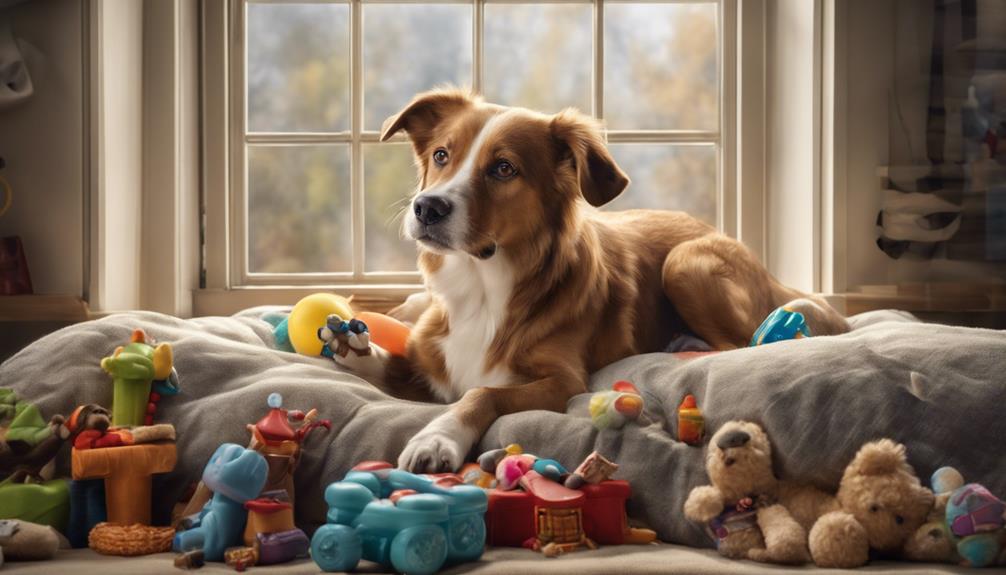
When dogs are missing their owners, engaging in comforting activities like playing favorite games can help alleviate their feelings of loneliness.
Providing mental stimulation through interactive toys can keep dogs occupied and offer a sense of stability in their owner's absence.
Creating safe spaces, such as cozy beds or designated areas, can give dogs a comforting retreat when they need it most.
Dogs Bonding Behaviors
Seeking out items imbued with their owner's scent, dogs demonstrate bonding behaviors that provide them with comfort and reassurance.
- Dogs often bring their favorite toy or blanket to their owner when feeling anxious or seeking connection.
- Licking their owner's face is a way for dogs to show affection and strengthen their bond.
- Watching the door or window for their owner's return is a common behavior that shows anticipation and attachment.
These behaviors help dogs feel secure and connected to their owners, easing any anxiety they may experience when separated.
Signs of Separation
Upon their owner's departure, noticeable changes in behavior may indicate how dogs cope with separation. Dogs often seek out items with their owner's scent, such as clothing or bedding, for comfort and positive associations. This behavior helps them feel connected to their owner even in their absence.
However, constantly smelling their owner's scent can sometimes lead to destructive behavior in dogs when they miss them intensely. Additionally, dogs may display signs of sadness like crying or howling when their owner leaves, showing their emotional response to the separation.
When their owner returns, dogs may show extra affection and happiness, reflecting their longing for them. Some dogs may exhibit intense zoomies and lean on their owner, further demonstrating how much they miss them during the time apart.
Ways to Comfort
To comfort dogs coping with the absence of their owners, providing ample exercise before departure can be beneficial.
Here are some ways to help your dogs when they miss you:
- Ensuring comfort by leaving necessary items like blankets or toys can offer familiarity and security to dogs.
- Leaving something with your scent, such as a piece of clothing, can provide comfort and a sense of closeness to your dog.
- Using Dog TV or calming music can help soothe dogs in the absence of their owners, reducing anxiety and stress.
Impact of Owner Absence on Dogs

When owners are absent, dogs often exhibit negative emotions like whining, pacing, and destructive behavior. This behavior stems from the strong bond dogs have with their owners, causing distress when separated.
Dogs miss their owners immediately after parting, showing signs of anxiety and sadness. Different breeds may display these emotions more intensely, such as poodles who are known for their strong attachment.
Coping with your absence can be challenging for dogs, as they struggle to understand the reasons behind your departure. The impact of owner absence on dogs can be seen in their behavior, with increased physical activity and restlessness during longer separations.
Understanding how dogs miss their owners is important in providing them with the care and support they need during these times of distress. By recognizing the signs of their yearning, you can better comfort and reassure your furry friend until your return.
Recognizing Dogs Yearning Behavior
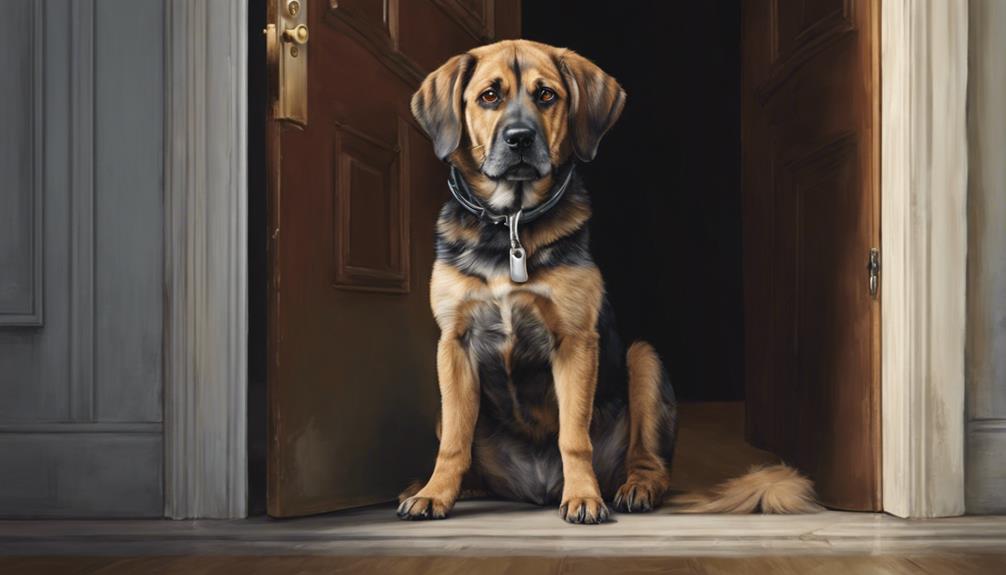
Recognizing dogs' yearning behavior can be crucial in understanding and addressing their emotional needs when separated from their owners. When a dog is missing their owner, it's vital to observe the signs of their yearning behavior to provide comfort and support during their grieving period.
Here are some key behaviors to look out for:
- Waiting by the door or window for their owners to return.
- Sleeping on their owner's belongings or seeking out items with their scent.
- Whining, pacing, or displaying stress signals indicating their yearning for their owner's presence.
Alleviating Dogs Emotional Distress

Alleviating dogs' emotional distress involves understanding and addressing their needs during times of separation from their owners. To help your dog cope with your absence, consider the following strategies:
| Strategy | Description |
|---|---|
| Provide Comforting Items | Leave familiar scents, toys, or clothing with your dog to provide comfort in your absence. |
| Maintain a Routine | Stick to a consistent schedule for feeding, walking, and playtime to create a sense of security for your dog. |
| Engage in Enrichment Activities | Keep your dog mentally stimulated with puzzle toys, interactive games, or training exercises to prevent boredom and anxiety. |
Dogs experience separation anxiety when their owners are away, but by implementing these techniques, you can help alleviate their emotional distress. Remember to be patient and understanding as your dog adjusts to your absence. By taking these steps, you can support your furry friend's well-being and strengthen your bond with them.
Building Stronger Bonds With Dogs

To build stronger bonds with dogs, remember to engage in playtime regularly. It helps strengthen the connection between you and your furry friend.
Establishing daily routines, such as feeding and walking schedules, can provide a sense of security and predictability for your dog. This consistency enhances your bond.
Additionally, pay attention to your body language and use positive reinforcement to communicate effectively with your pet. This approach reinforces the bond you share.
Bonding Through Play
Playing with our dogs not only brings joy but also strengthens the bond between us and our furry companions. When engaging in interactive play, we're enhancing our relationship with our dogs in several ways:
- Trust Building: Interactive playtime activities help foster trust and companionship between us and our dogs.
- Communication: Dogs view play as a form of communication, allowing them to connect with us on a deeper level.
- Stress Reduction: Incorporating play into our routines helps dogs release pent-up energy and reduces stress, leading to a happier and more relaxed pet.
Establishing Routines Together
Establishing daily routines with our dogs fosters a sense of security and predictability, strengthening the bond between us. Consistent feeding times, regular walks, and dedicated play sessions help our furry friends feel secure and connected.
These daily routines offer mental stimulation and physical activity, reducing anxiety and fostering a harmonious relationship. Dogs thrive on routine as it clarifies expectations and provides stability in their environment.
Communicating With Body Language
Understanding our dogs' body language is essential for building strong bonds and effective communication with our furry companions. When we pay attention to how they're expressing themselves, we can create a deeper connection.
Here are some key points to keep in mind:
- Dogs use tail wagging, ear position, and eye contact to communicate their emotions.
- Body posture can indicate whether a dog is feeling happy, anxious, excited, or aggressive.
- Learning to interpret and respond to these signals can help owners understand their dogs better, especially when they're left alone.
Providing Support for Dogs

To help dogs cope with missing their owners, maintaining consistent routines and providing extra affection can offer essential support during this challenging time. Dogs are social animals that thrive on familiarity, so sticking to their usual schedule can help provide a sense of stability. Additionally, offering more cuddles, playtime, and attention can reassure them and alleviate feelings of loneliness. Engaging in activities that they enjoy, such as going for walks or playing with their favorite toys, can also help distract them from missing their owners.
| Support Tips for Dogs | Description |
|---|---|
| Stick to Consistent Routines | Maintain regular feeding times, walks, and play sessions to provide comfort. |
| Provide Extra Affection | Offer more cuddles, belly rubs, and attention to reassure and comfort them. |
| Engage in Favorite Activities | Participate in activities that they love to keep them mentally stimulated. |
Frequently Asked Questions
How Long Does a Dog Miss Their Owner?
We miss our owners for varying durations, which could range from a few hours to a couple of weeks. This time frame depends on individual differences and the bond we share with our humans.
It's important to show patience and care during this period, as our emotions can be intense. Understanding our behavior cues and providing comfort can help ease our longing for our beloved owners.
How Do You Know if Your Dog Has Missed You?
When your dog has missed you, signs may include increased clinginess, seeking attention, or pacing before your arrival. Some dogs may display behaviors like watching the door or window, whining, or following you around.
Understanding your dog's unique ways of showing affection can help you recognize when they miss you. Pay attention to their body language and behavior patterns to strengthen your bond and meet their emotional needs.
Do Dogs Think About You When You're Gone?
Yes, dogs do think about us when we're gone. Signs like whining and pacing show they miss us. Some breeds like poodles exhibit stronger attachment behaviors.
Dogs start missing us immediately after we leave, with emotions peaking up until two hours post-departure. This feeling can persist until we return, showing a continued sense of missing.
Dogs also display negative emotions like sadness and anxiety when we're away.
Do Dogs Think Their Owners Won't Come Back?
We can reassure you that dogs may indeed worry about their owners not returning. Separation anxiety can lead them to believe that their owners won't come back.
Signs like whining, pacing, and destructive behavior can indicate their concerns. It's essential to provide reassurance and maintain a consistent routine to help dogs feel more secure about our return.
Understanding these behaviors can help us support our furry friends during times of separation.
Is My Dog Staring at Me a Sign of Missing Me as Their Owner?
Yes, “why dogs stare at me” can be a sign of missing their owner. Dogs use eye contact to communicate and show affection. When your dog stares at you, it can be a way of showing their attachment and longing for your attention. It’s their way of saying they miss you.
Conclusion
To sum up, dogs do miss their owners, showing signs of separation anxiety through various behaviors and emotional displays. By identifying these signs and offering assistance, we can help alleviate their distress and forge stronger bonds with our furry friends.
Remember, a dog's love for their owner is as strong as a hurricane, so it's crucial to nurture and take care of them to guarantee their well-being and happiness.






